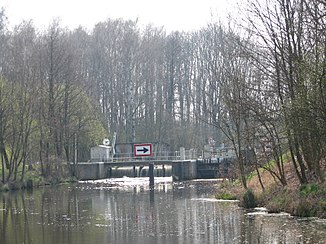Notte
|
Notte Notte Canal |
||
|
Lock near Mittenwalde (replacement from 1960) |
||
| Data | ||
| location | Districts Teltow-Fläming and Dahme-Spreewald , Brandenburg , Germany | |
| River system | Elbe | |
| Drain over | Dahme → Spree → Havel → Elbe → North Sea | |
| source | south of Sperenberg | |
| muzzle | in the port of Königs Wusterhausen in the Dahme coordinates: 52 ° 18 '28 " N , 13 ° 38' 37" E 52 ° 18 '28 " N , 13 ° 38' 37" E
|
|
| length | 24.8 km | |
| Flowing lakes | Mellensee | |
| Ports | Koenigs Wusterhausen harbor | |
| Navigable | to the Mellensee for small vehicles | |
|
Lock at Königs Wusterhausen (replacement from 1983/84) |
||
The Notte is a left tributary of the Dahme in the districts of Teltow-Fläming and Dahme-Spreewald in the state of Brandenburg (Germany). It rises south of Sperenberg and joins the Dahme waterway below the Neue Mühle lock in Königs Wusterhausen .
history
The Nottefließ was the first long waterway in the Mark Brandenburg that was made navigable by humans. Its first expansion with locks is dated to the reign of Elector Joachim II around 1568. Between 1856 and 1864 the waterway was extensively expanded by an amelioration association to a length of 25 km between the Mellensee and its mouth at Königs Wusterhausen.
The Notte, which was built with barrages from the start, was referred to as the canalised Notte , as was common at the time . This has erroneously become a Notte Canal . The concept of canalization corresponds today to the congestion regulation . The Prussian Water Act also lists the notte under natural and not artificial watercourses.
The jam-regulated Notte used to be of considerable importance for the supply of Berlin with agricultural products and building materials. The Sperenberg gypsum stones, but also the products of numerous brickworks and gravel pits were transported by water. Due to the expansion of the railway network (especially the Mittenwald private railways KMTE and NME ), the importance of the Notte decreased. Due to the influences of the Second World War and changing problems with bridges and locks, commercial shipping came to a complete standstill , with the exception of the port of Königs Wusterhausen .
Todays use
The dam-regulated Notte (Nt) is navigable and has three locks , one at the outflow of the Mellensee , one just before Mittenwalde and one in Königs Wusterhausen. Since the lock in Königs Wusterhausen is only 21 m long, the Notte can no longer be used by cargo ships today. One kilometer of the estuary is one of the so-called other inland waterways of the federal government under the responsibility of the Berlin Waterways and Shipping Office .
At the Mittenwalde lock, the Gallun Canal flows into the Notte via its own lock. The Motzener See can be reached via this channel . At Ragow , directly in front of the Bundesautobahn 13 Berliner Ring - Dresden , the non-navigable Zülow Canal joins the Rangsdorfer See from the left . Between the Königs Wusterhausen train station and the Dahme, the Notte has been expanded into an inland port .
In the present there is a tourist use.
The original purposes of amelioration
- Drainage of agricultural land
- Lowering the level of the Rangsdorf lake
- Drainage of the seepage water from the sewage fields
are no longer persecuted today, rather neglected.
Long periods of heavy rain cause the groundwater level to rise and thus impair residents.
literature
- H.-J. Uhlemann, Berlin and the Märkische Wasserstraßen, DSV-Verlag Hamburg 1994
Web links
Individual evidence
- ^ [1] Water catalog of the German Rowing Association
- ↑ Water Police Ordinance for the Brandenburg waterways of March 15, 1915, §§ 167-170
- ↑ Annex to the Prussian Water Act of April 7, 1913 (Collection of Laws No. 14/1913)
- ↑ Lengths (in km) of the main shipping routes (main routes and certain secondary routes) of the federal inland waterways. Retrieved March 9, 2020 .
- ↑ Gudrun Schneck: Clear ship for water tourists . In: Märkische Allgemeine from February 7, 2013

